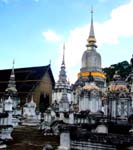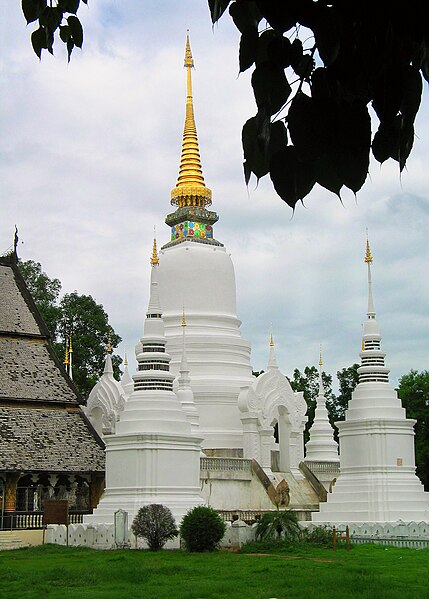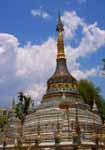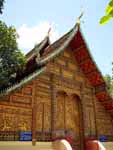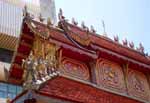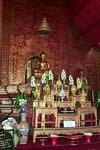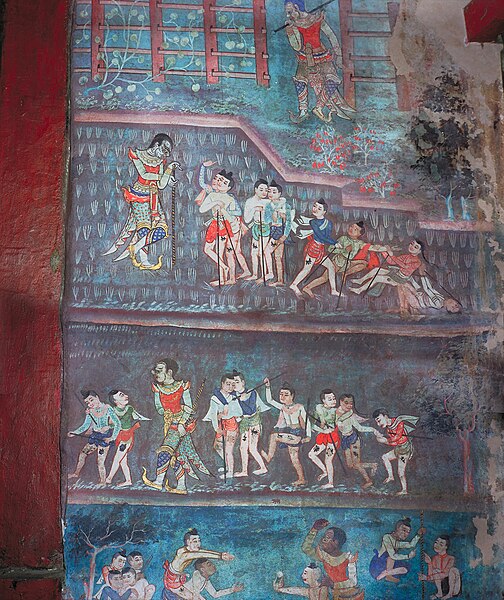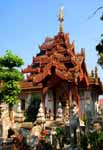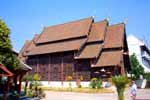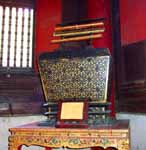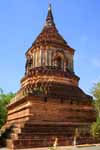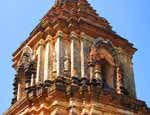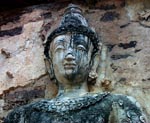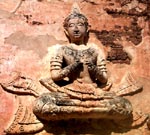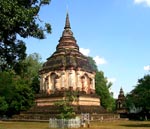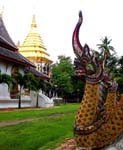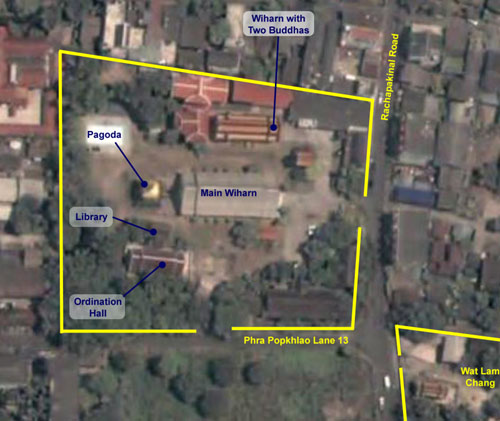
Sri Suphan Aram or Wat Sri Suphan is situated to the south of Chiang Mai town between the outer wall and the inner wall. In the past it was one of the Temples within the juristiction of Wat Nantaram, depending on Wat Muen Sarn.
According to the Ubosot section of Wat Nantaram in the period of Chao Intanon, the 7th King of Chiang Mai in the Kawila period (1871-1897), there were 9 Principal Temples as follows:
1. Wat Muen Sarn, near the Haiya gate outer Chiang Mai town
2. Wat Nantaram, near the Khua Gom Gate, outer Chiang Mai town
3. Wat Phuak Pia, near the Haiya Gate, outer Chiang Mai town
4. Wat (Sri) Suphan, near the Haiya gate, outer Chiang Mai town
5. Wat Hua Fhai, near the Lhai D?ng gate (later on called Ra G?ng), outer Chiang Mai town
6. Wat Yang Guang, near the Khua Gom gate, inner Chiang Mai town
7. Wat Gudeekham, near the Khua Gom gate, inner Chiang Mai town
8. Wat Mueng Marng, near the Lhai D?ng gate, outer Chiang Mai town
9. Wat Dao Wa Dueng ,near the Lhai D?ng gate, outer Chiang Mai town.
2. Wat Nantaram, near the Khua Gom Gate, outer Chiang Mai town
3. Wat Phuak Pia, near the Haiya Gate, outer Chiang Mai town
4. Wat (Sri) Suphan, near the Haiya gate, outer Chiang Mai town
5. Wat Hua Fhai, near the Lhai D?ng gate (later on called Ra G?ng), outer Chiang Mai town
6. Wat Yang Guang, near the Khua Gom gate, inner Chiang Mai town
7. Wat Gudeekham, near the Khua Gom gate, inner Chiang Mai town
8. Wat Mueng Marng, near the Lhai D?ng gate, outer Chiang Mai town
9. Wat Dao Wa Dueng ,near the Lhai D?ng gate, outer Chiang Mai town.
1. Wat Sri Suphan in the Mangrai Period
(1st engraving) In 1500 the King of
Chiang Mai and his mother asked Chao Muen Luang Jha Kham Rang Karn to
bring a Buddha image and to put it in the Maha Viharn named Sri Suphan
Aram. Later on in the year of turtle, the king invited Maha Therayaan
Ton, from Wat Muen Sarn, to be the Abbot in the Temple; in the year of
the pig the foundation of the Maha Viharn was celebrated; in the year of
the rabbit the stupa for the Buddha relic was built; in the year of the
small snake the Ubosot was founded; and then they invited Phra Rachakru
to bring Lord Buddha’s relic for the stupa.
2. Wat Sri Suphan in the King Kawila Period
At that time the authorities moved people to repopulate the town, which had stood empty after being sacked by the Burmese. They moved those who were skilled in silverwork into the Wat Muen Sarn and Wat Sri Suphan area, making a new community in that area.
All these people came from the Kong river area near Chiang Rai, as indeed did the monks. Later on they made a list of all Temples in Chiang Mai, and they put Wat Sri Suphan in the Kong sect. This is why people in the community are known as Kong Nam Ha.
In the period of King Kawilorot (1856-1870), the King together with his wife Chao Usa, built the golden bell and had it brought to Wat Phra That Doi Suthep. It appears that the old Viharn, before the renovations (1994-1998) was built in the period of King Kawilorot.
3. Wat Sri Suphan in the late 19th and early 20th centuries
In the period of King Kawilorot and King Intayanon (1856-1876), Wat
Sri Suphan, Kong sect had Chao Atikarn Tu Sithi as the Abbot and deputy
was Tu Inthajak.In the late 19th century Wat Sri Suphan was still a center for learning in the community. The local people brought their children to ordain and study there until they had a chance to become monks. When they had finished their duties they would then return back to their community.
At the beginning of this period the monks would still act as teachers in the Temple, using the hall as a classroom, but in 1921 the Education Act called for boys and girl to study in state-run schools.
In 1923 Khun Janya, the education officer of Chiang Mai, joined with Wat Sri Suphan when Phra Inta Tammawong was the Abbot, to create a primary school in the Temple with the help of various well-wishers.
4. Wat Sri Suphan during World War II
During World War II the Japanese used the Temple as a military camp. There were plenty of Japanese soldiers, and also captives who were kept inside a bamboo enclosure. In front of the Temple near the outer wall was a stable for horses and a distribution center for the soldiers.
At that time the Wat Sri Suphan school had to close because the Japanese took charge of the Temple. During this period the Viharn was destroyed by allied bombing, and the people had to build their own shelters. Many of the students had to move to Wat Sri Ping Muang school.
After the end of World War II the Temple was run down and covered with weeds and bamboo, and there were crows and other birds making their nests in the Temple. At that time Wat Sri Suphan had only 2 monks and 3 novices, but the faithful lay people and monks started to make a new Temple wall with two halls still standing in the grounds.
When the school reopened the students used the hall for their studies until a simple one-storey building was put up.
5. Wat Sri Suphan after World War II
In 1963 when Phra Kru Sathid Boonyanan was the Abbot and Kru Auen
Klangwichien was the Headmaster, the school was brought under the
jurisdiction of the Chiang Mai municipality, and at that time they
received the money to build a two-storey building, which was finished in
1964, and again in 1975-1977 the school was expanded to three storeys.The school is in the Temple, and uses the colours of yellow to represent the Temple and red to represent the nation. Many of the former students have been successful in their life and works, and were able to go on to higher education.
A number have become government officers and are working in the community, while some took up silverwork, working at home or in the surrounding communities such as Kampan-Boonyuen Mekbangwan, Duanrit-Prapai Chaiwut, Boonsong-Buakham Jaingarm and the Chiang Mai Silver Shop.
6. Wat Sri Suphan in the 1990s
In 1991 the silver community around the Wualai road on Baan Wualai
and Wat Sri Suphan received an important job, making a Silver Bowl to
commemorate Princess Theparat Ratchasuda’s 36th anniversary on 2nd April
1991. This helped in the recovery of the silver craftsmen on Waulai
road.Again in 1992 there was the Queen’s 60th anniversary and they made a Silver Bowl with 109 cms. diameter, the base having four elephant heads carved with teak, and covered with gold leaf, which was presented to Her Majesty at her palace in Chiang Mai.
In 1996 there was a 50th year anniversary ceremony for the King’s ascension to the throne; and in the same year the 700th year anniversary of the founding of Chiang Mai. Palakorn Suwannarat, the governor of Chiang Mai governer prepared another Siver Bowl having 139 cms. diameter, 69 cms. height and 199 cms. circumference, which was coated with gold leaf and decorated with lotuses.
The silver craftsmen who created these elaborate works were all proud of their work and it gave them the courage to keep up their handicraft work, even up and till the present day.

7. Wat Sri Suphan at Present
Because of the history of the Temple and its involvement in the community, Phra Atikarn managed to get a lot of cooperation from the local people, as well as from local governmental organisations, acadamies, business people, and other upstanding members of the community to join him in preserving the heritage of Wat Sri Suphan, and the community in the area by various works, such as:
1) Renovation of the Viharn
A major renovation of the Viharn happened during King Kawilorot
(1856-1870). The evidence shows that he and his wife, Chao Usa, had the
initiative to renovate the Viharn in 1860, and had a golden bell made
that now stands in front of Wat Phra That Doi Suthep.Between 1994-1998 the committee of Wat Sri Suphan, with the support of the Abbot Phra Atikarn Suphol Sutthisilo, renovated the Viharn one more time after receiving contributions from people around Phra Viharn.
The paintings in the Viharn are by the artist Chaiporn Pongpak, and impress people both in Chiang Mai itself and the foreigners who visit the Temple, with their beautiful light and colors, which harmonizes with the work of the silver craftsmen, which also adorn the walls.
He was helped by Pornchai Chaima and Sondej Thipthong, who form a group of Buddhist Lanna Artists who began working together in 1992, and have worked together by painting in many Temples such as Wat Bupparam (Tha P? road), Wat Sri Maram (Baan Mon, Sankamp?ng) and Wat Tha Kham (Tambon M? Heay).
In 1994 the Buddhist Lanna Artists group volunteered to paint inside the Viharn of Wat Sri Suphan. They joined together with Sachiko (a Japanese artist), Peter (an Australian artist), Roland (an English art student), Gularp (a Canadian having a Thai name), Mali (an American having a Thai name) and her family. M.D. Anand Sritapan provided the financial support for the complete costs of the painting, and the silver craftsmen, who were led by Direk Sithikarn.
2) The Making of Phra Chao
The year 2000 saw the 500th year anniversary of Wat Sri Suphan, and
the committee, together with the Abbot, organised a festival to
celebrate 500 years of Lanna Heritage during 29-31 March 2000, making a
new Buddha Statue (Phra Chao) with the support of the local people.
3) Creating an Education Center
The Abbot gave one area of the Temple for the learning center for people who are interesting in silverwork and created special activities for them. Later on that expanded to become a learning center for ancient Thai Art.
The National Buddhist Office and the Kanchanapisek Learning Center have helped the center become a very successful place where monks, novices and local people can learn the local handicrafts. It is now popular with many people both from home and abroad.
The Abbot also discussed with some knowledgeable people and made the Phra Pikkanet (Ganesh) statue as he is the patron of skilled workers, and they established it between the Scripture House and the Ubosot in April 2007.
There is also a Buddhist Education Center in Wat Sri Suphan every Sunday, which is administered by one Abbot who worked at Wat Suan Dok for a while.
4) Economic Activities in Wualai Road
In 2002 the community at Wualai 3. Wat Sri Suphan, Wat Muan Sarn and
Wat Nantaram participated in and organised various cultural and economic
activities on 6th-7th December; and again on 3th-4th January, 2003 at
Wat Nantaram.Boonlert Buranapakorn, the Governor of Chiang Mai, organised another occasion on 15-16 March, 2002. There is now a Saturday Market every week where people can buy goods produced by local craftsmen, which is supported by the Governor.

5) Renovation on Phra Ubosot
In 2004 the committee of Wat Sri Suphan, supported by the Abbot, agreed to renovate the Ubosot again by using skilled local craftsmen so it will become the first Silver Ubosot in the world.
During the 80th anniversary of the King Rama IX in 2007, the Committee of Wat Sri Suphan and the Abbot agreed to present this Silver Ubosot to the King to honor his anniversary.
Since then the Crown Prince has honored Wat Sri Suphan by giving permission to place a photo of the King in front of the Silver Ubosot on 20 March, 2009, the 60th anniversary of his ascension to the throne; and in 2010 Wat Sri Suphan had the honor of the King holding the Kathina at the Temple on 13 November.
The Vision of Sri Suphan Temple
By Ven. Phra Kru Pitak Suddhikhun
Abbot of Srisuphan Temple
Our Vision:
A commitment to sustain Buddhism, its culture and traditions in conjunction with the development of a local education center and a sustainable economic community.
History:
According to the inscriptions found locally on Red Sandstone, King Muang Kæw (1495–1525) of the Mangrai dynasty and his mother ordered a military offical called Khun Luang Jha Kham to bring a Buddha statue to this place and they built a Temple in the year 1500 CE. In ancient times the Temple was called Sri Suphan Aram.
Later, the Vihara, Chedi and Ubosot were built in that order and were completed around ten years later. All the buildings together with the surrounding areas and twenty families were given to take care of the Temple.
Present:
Sri Suphan Temple has been a vast source of knowledge concerning the art, culture, education and handicrafts, including lost-wax casting and silverwork, from the past until the present.
There is still a living culture regarding these handicrafts, but knowledge about statue-casting, silverwork and other handicrafts are in danger these days owing to the changing times and there are not many people to whom this knowledge is being passed on.
Ven. Phra Kru Pitak Suddhikhun, the Abbot since 1992 of Sri Suphan Temple, and the Committee of Sri Suphan are well aware of the problems and intend to preserve and maintain the heritage passed down in the culture from their predecessors.
Therefore they have outlined many activities that are needed to lead to the vision, mission and objectives of the Temple. They are supported by the Sangha in Chiang Mai, and also by the National Buddhism Office, the Government and by the private sector who appreciate the local culture and knowledge especially in regard to Lanna craftsmanship at Sri Suphan Temple.

Current Tasks, Activities & Projects:
1. To sustain the propagation of the
Dhamma, the traditions and local culture by playing a critical role as a
Temple in the local community.
2. To encourage and collaborate with the Education system under the Royal Act on Education in 1998.
3. To maintain and promote indigenous silver handicrafts.
We propose to support these aims as follows:
• Establish a group of craftsmen trained in the Lanna traditions at Sri Suphan Temple (ongoing from 2000 CE – Present).
• Establish a study center for ancient Lanna Arts at Sri Suphan Temple.
• Establish a distribution center for the products produced at the Sri Suphan community. The Community was selected by a Government scheme to promote local production. This effectively generates income for the local people.
• Hold a Saturday Market on the nearby Wualai Road with the collaboration of the Sri Suphan, Wat Muean Sarn and Wat Nantaram communities. This is supported by the Chiang Mai Municipality. These events have rapidly helped to build up economic development in the community.
• Build a Silver Ubosot at Sri Suphan Temple, dedicated to promoting the dispensation of the Buddha and glorifying His Majesty, King Bhumibol Adulyadej on the anniversary of his 84th birthday. The decoration is made with silver and aluminum handicrafts, a heritage that has been passed down from our predecessors over the past 200 years. The original Ubosot was a brick structure plastered with cement. The dimension of the new Ubosot is 50m long, 17m wide and 18m high, and is in traditional Lanna style. The renovation of this building has been going on since the year 2005, and so far (2010) 12 million baht have been spent, and the progress of the work is about 60 percent complete. An additional 13 million baht will be needed to complete the renovation.
• Monk Chat and Meditation Programs provided to foreigners so they can learn the Buddha’s teaching and get advice from monks for beginning meditation. Currently the program is available three days a week, on Tuesday, Thursday and Saturday (Monk Chat is from 5.30pm – 7.00pm and Meditation is from 7.00pm – 9.00pm).
• A Learning Center for silver handicrafts and Lanna folk art (this initiative has yet to start).
The projects are based on the doctrine and discipline in Buddhism,
integrated with the King’s philosophy of economic sufficiency to achieve
the sustainability of the Buddha’s dispensation, local communities and
the country.• Establish a study center for ancient Lanna Arts at Sri Suphan Temple.
• Establish a distribution center for the products produced at the Sri Suphan community. The Community was selected by a Government scheme to promote local production. This effectively generates income for the local people.
• Hold a Saturday Market on the nearby Wualai Road with the collaboration of the Sri Suphan, Wat Muean Sarn and Wat Nantaram communities. This is supported by the Chiang Mai Municipality. These events have rapidly helped to build up economic development in the community.
• Build a Silver Ubosot at Sri Suphan Temple, dedicated to promoting the dispensation of the Buddha and glorifying His Majesty, King Bhumibol Adulyadej on the anniversary of his 84th birthday. The decoration is made with silver and aluminum handicrafts, a heritage that has been passed down from our predecessors over the past 200 years. The original Ubosot was a brick structure plastered with cement. The dimension of the new Ubosot is 50m long, 17m wide and 18m high, and is in traditional Lanna style. The renovation of this building has been going on since the year 2005, and so far (2010) 12 million baht have been spent, and the progress of the work is about 60 percent complete. An additional 13 million baht will be needed to complete the renovation.
• Monk Chat and Meditation Programs provided to foreigners so they can learn the Buddha’s teaching and get advice from monks for beginning meditation. Currently the program is available three days a week, on Tuesday, Thursday and Saturday (Monk Chat is from 5.30pm – 7.00pm and Meditation is from 7.00pm – 9.00pm).
• A Learning Center for silver handicrafts and Lanna folk art (this initiative has yet to start).
The Result over the Past 10 Years:
Even though there is a change in development that has contributed to a positive outcome for the community, the approach has not yet lead to the achievement of all our goals on each project as expected. There are various obstacles that have been encountered, which we can list as follows:
1. Social problems such as varieties of
nationality, conflicts of interest, competition, non-cooperation, a lack
of self-sacrifice and so on.
2. Insufficient liquidity to run the projects. The fund is fluctuating and relies only on donors. The projects are not firmly established and remuneration is unpredictable, making it difficult to proceed.
3. A lack of awareness about our cultural heritage and local knowledge, and a lack of motivation.
4. A lack of good public relations with the public in terms of communicating our objectives.
Such problems and obstacles have been encountered, but Sri Suphan
Temple and those who are involved have been seeking a solution to these
problems and making efforts to overcome them. However, to achieve the
task they need support from the Government, the private sector and those
who appreciate the local culture and knowledge, by participation at all
levels to achieve our objectives together so as to sustain the Lanna
traditions and keep alive the dispensation of the Buddha, and to glorify
our King Rama IX of the Chakri Dynasty.2. Insufficient liquidity to run the projects. The fund is fluctuating and relies only on donors. The projects are not firmly established and remuneration is unpredictable, making it difficult to proceed.
3. A lack of awareness about our cultural heritage and local knowledge, and a lack of motivation.
4. A lack of good public relations with the public in terms of communicating our objectives.
Silver Ubosot: Innovative Folk art and Creative Silver Handicrafts
Concept/Background:With the integration of the dispensation of the Buddha and the local Wualai Silver Handicrafts, the heritage which has been passed down from our forefathers over the past 200 years. This gives even more value to the project to rebuild the Ubosot that housed the Buddha statue offered by King Muang Kæo since the year 1500.
Determination:
To be the first religious building built with fine silver and aluminium handicrafts in the world, dedicated to promoting the dispensation of the Buddha and to glorify His Majesty, King Rama IX of the Chakri Dynasty.
Construction:
Restoration of the building from the base of the original Ubosot to the boudaries established for the monks’ disciplinary actions. The dimension of the rebuilt Ubosot is 50m long, 17.50m wide and 18m high, and it is being built in traditional Lanna style.

Art:
The artistic embellieshments of the Temple are being prepared by a group of craftsmen trained in the ancient Lanna traditions at Sri Suphan Temple, and also in the local Wualai Silver handicrafts community.
Decoration:
With the skill of the Wualia Silver craftsmen the decoration is being made with silver and aluminium decorating the roof and the walls, both of the inside and outside.
Time:
The building commenced in 2005, and has been going on ever since. Completion is expected to be around the year 2015, if other factors allow.
Budget:
The budget is set at 25 million baht and so far the progress of the work is about 65 percent complete. An additional 12 million baht will be needed to complete the renovation.
Expectancy:
The Silver Ubosot to expected to become a treasure of the Thai nation and the dispensation of the Buddha through the contributions coming from the Government, the private sector and all Buddhists who participate in building this Ubosot and glorifying His Majesty, King Rama IX of the Chakri Dynasty.
Monk chat
Dhamma talk
we would like to invite all people who interesting on December,31,2011,begin 7.00 p.m.- 9.30 p.m.we will set up special program of dhamma talk and meditation practice, the topic of dhamma talk is ‘The buddha and his teaching” to help you and your problem. every one can join to listening and ask to question.
following to program
1. To listening the dhamma talk “The buddha and his teaching” 7.00 p.m. – 8.00 p.m.
2. Quiz 8.00 p.m.- 8.30 p.m.
3. To practice meditation 8.30 p.m. – 9.00.p.m.
we would like to invite all people who interesting on December,31,2011,begin 7.00 p.m.- 9.30 p.m.we will set up special program of dhamma talk and meditation practice, the topic of dhamma talk is ‘The buddha and his teaching” to help you and your problem. every one can join to listening and ask to question.
following to program
1. To listening the dhamma talk “The buddha and his teaching” 7.00 p.m. – 8.00 p.m.
2. Quiz 8.00 p.m.- 8.30 p.m.
3. To practice meditation 8.30 p.m. – 9.00.p.m.


